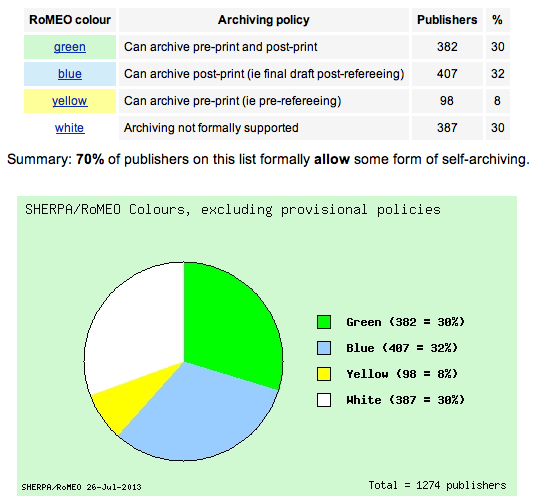The Open Access publication course
Thanks to the Open Access movement, dissemination and accessibility of scientific publications have greatly evolved those last decades. Particularly related to the progress of online technologies, this evolution responds to the high demand of scientists to enhance the spreading of research results. This evolution can be assess through different statistics provided by key actors in this domain. As the Open Access movement begins with the green way of Open Access more statistics are provided for it.
In the research world, publications play an important role. In fact, thanks to them, all research results are spreaded to the scientific community. However, for years, those publications could only be reached through paid subscriptions. Allowing a free of charge access to scientific publications online represents the Open Access movement. Generally free of most usage restrictions (copyright and licensing), it also allows researchers to freely reused the publication results.
Two different ways exist in the Open Access movement. In the Green Open Access model, researchers put directly online and without charge their non peer-reviewed papers (preprints), peer-reviewed papers (postprints), thesis, etc. in open archives or repositories. In the Gold Open Access model, researchers publish papers in online Open Access journals which generally apply processing charges and peer-review processes. See our previous posts “Outline of Open Access” and “New practices in scientific peer review” for more information on these two subjects.

 This work is licensed under a Creative Commons Attribution-NonCommercial-ShareAlike 2.5 License
This work is licensed under a Creative Commons Attribution-NonCommercial-ShareAlike 2.5 License

By giving free access to research publications, it is expected a greater dissemination of knowledges toward the scientific community. Since the creation of the first archive in 1991 (arXiv), more researchers contribute to the green Open Access by self-archiving their papers in open archives or repositories. The SHERPA/RoMEO platform provides several statistics concerning the publisher policies for self-archiving. According to it, 30% of the publishers referenced in their database allow researchers to deposit both preprints and postprints in a repository. 32% can archive only postprints, 8% only preprints, and 30% can’t deposit any of them (statistics seen on 26 July 2013). Concerning the funder policy statistics, the platform SHERPA/JULIET provides good results. According to this website, 60% of world funders require publication archiving (statistics seen on 25 July 2013). To find green Open Access papers, several websites such as OpenDOAR exist. This platform also provides different kind of statistics like the percentage of repositories by continent, their more frequent content type, etc.
Concerning the gold Open Access, different informative platforms also exist. Since the PLOS publishing project initiated with an online petition in 2000, many journals are now available. The DOAJ platform provides a database of Open Access journals. On 25 July 2013, 9970 journals from around the world are referenced on this website. DOAJ also allows you to see the evolution of Open Access journals by providing a table of the number of journals registered by year and by country since 2002. For example for the United States, 16 journals were registered in 2002, and 1381 journals are now registered at this date. Thus, more and more Open Access journals are now available for researchers. Moreover, according to SHERPA/JULIET, 21% of world funders are now requiring Open Access publishing (statistics seen on 25 July 2013).
Thus, trough those few examples, we can see that the Open Access model continuously evolves since its beginning. To find more information, see the Dramatic Growth of Open Access Series of the librarian Heather Morrison.


 Share on Facebook
Share on Facebook Share on Twitter
Share on Twitter